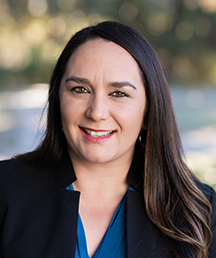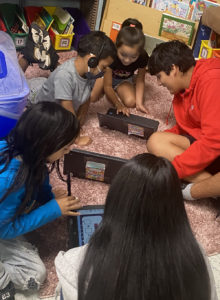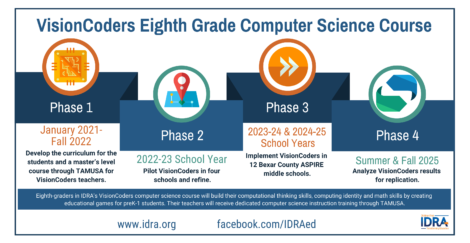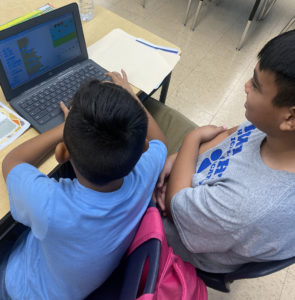By Stephanie Garcia, Ph.D. • IDRA Newsletter • November-December 2022 •

In IDRA’s new course, middle school students who are in at-risk situations are becoming software designers. Eighth graders in two South San Antonio ISD schools are piloting the IDRA VisionCoders class to create educational games for prekindergarten, kindergarten and first grade students.
VisionCoders is a new eighth grade computer science course being developed by IDRA in partnership with Texas A&M University–San Antonio and 12 schools in seven Bexar County school districts. In 2022-23, the program will expand to all 12 schools, serving 1,400 eighth grade students in at-risk situations from seven school districts where fewer than 1% of students take a computer science class.
While the project targets high-need students with limited computer science opportunities, it is inspired by the needs of PreK-1 students identified amidst the COVID-19 crisis. As young students struggled to navigate and adapt to online learning, the pandemic forced schools and communities to rethink early childhood online educational resources and remote learning pedagogical practices. VisionCoders gives students the opportunity to contribute solutions – a vision in the face of unprecedented challenges – while learning valuable computer science skills and identities.
During the pandemic, middle and high school tutors in IDRA’s Valued Youth Partnership (VYP) observed that their young tutees in kinder and first grade were struggling with their academics. These student observations in the COVID-19 era sparked the idea for VisionCoders, which is a five-year Education, Innovation and Research grant from the U.S. Department of Education.
Asset-Based Approaches to STEM-CS Education
The VisionCoders program is strongly aligned with the philosophical foundation and tenets of IDRA’s highly successful VYP program:


IDRA is partnering with Palo Alto College and Athens Elementary School this year as our participating buddy campuses within South San Antonio ISD. Each month, VisionCoders students build educational game prototypes aimed to enhance their buddy’s math and literacy skills.
- All students can learn.
- Schools value all students.
- All students can actively contribute to their own education and to the education of others.
- All students, parents and teachers have the right to participate fully in creating and maintaining excellent schools.
- Excellence in schools contributes to individual and collective economic growth, stability and achievement.
- Commitment to educational excellence is created by including students, parents and teachers in setting goals, making decisions, monitoring progress and evaluating outcomes.
- Students, parents and teachers must be provided extensive, consistent support in ways that enable students to learn, teachers to teach and parents to be involved.
Social-Emotional Learning and Student Engagement
Another important lesson learned during the pandemic is how important social-emotional learning and student engagement is. Increasing opportunities for inquiry and outside experiences are exemplary practices in terms of increasing social-emotional learning and student engagement. These experiences are embedded throughout VisionCoders.
VisionCoders students rise to the challenge and engage deeply in the mentoring process with their elementary buddies. We have witnessed how this experience is already strengthening student perceptions of self and school, as well as their sense of belonging.
The deeper connection to a community need gives VisionCoders students a heightened sense of self-efficacy and engagement and a sense of urgency to deliver products to younger children they personally know and have built relationships with.
Increasing Representation, Access and Opportunities In and for STEM-CS Learning
Three embedded components in the VisionCoders program include educational field trips held at least twice throughout the year for VisionCoders students to explore economic and cultural opportunities. The field trips are an opportunity for career awareness by exposing the students to a variety of professional environments. They can make more connections between what they are learning in school and what they will need to know to work as professionals.
Second, in the mentorship component, STEM professionals and college student mentors visit VisionCoders students throughout the school year to share more about their STEM-Computer Science (CS) journeys, provide feedback on VisionCoders coding projects, and answer any questions they have concerning the STEM-CS field and college and career pathways.

And third, VisionCoders students will be invited to join a paid summer internship experience immediately following the school year. This will provide all incoming high school students with work-based experiences that align to the STEM-CS career opportunities explored throughout their class.
These concepts are crucial to supporting the STEM-CS pipeline specifically on the south side of San Antonio. IDRA’s data analysis of the VisionCoders target school districts shows that adult employment trends in computer-related fields fall well below the national average of 7%. According to our findings, in the largely Latino geographic area, fewer than 1% of adults work in computer-related fields.
But today’s fastest-growing careers are tech-driven from healthcare to telecommunications to aerospace. The U.S. Bureau of Labor Statistics projects computer science research jobs alone to increase 19% by 2026. And 67% of all new jobs in STEM are in computing.
Project-Based Learning and Design-Thinking Frameworks
The educational approaches of project-based learning and design-thinking frameworks inform the VisionCoders course design and curriculum development, leaning into asset-based and innovative practices. Educators teach block programming and video game design through Scratch and Code.org platforms. By scaffolding skills and creating games, the VisionCoders course builds confidence among students, who have little or no computing or programming skills, to plan out increasingly complex games and activities.


A VisionCoders student from Dwight Middle School leading his Athens Elementary School buddy through a game programmed especially for him.
Such meaningful and purposeful connections are exactly what the computer science education community recommends. Each VisionCoders student creates a portfolio of products to showcase at the end of the year to the broader community. Feedback from experts and community members are essential tenets of project-based learning and design-thinking frameworks. And student recognition for their hard work is an essential component of VisionCoders.
Join VisionCoders!
During the 2023-24 and 2024-25 school years, we will expand to 12 middle school campuses participating in the VisionCoders program. Participating school districts include East Central, Edgewood, Harlandale, Somerset, South San Antonio, Southside and Southwest ISDs. Depending on enrollment numbers, we are open to including other districts. If you or someone you know in these districts are interested in joining IDRA’s VisionCoders program, please share this article with them and have them contact me at stephanie.garcia@idra.org.
Stephanie García, Ph.D., is IDRA’s STEM and gender equity education specialist and directs the IDRA VisionCoders program. Comments and questions may be directed to her via email at stephanie.garcia@idra.org.
See IDRA’s STEM Equity – Online Technical Assistance
[©2022, IDRA. This article originally appeared in the November-December 2022 issue of the IDRA Newsletter by the Intercultural Development Research Association. Permission to reproduce this article is granted provided the article is reprinted in its entirety and proper credit is given to IDRA and the author.]


